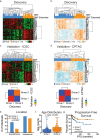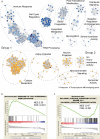Integrative multi-omics reveals two biologically distinct groups of pilocytic astrocytoma
- PMID: 37656187
- PMCID: PMC10500011
- DOI: 10.1007/s00401-023-02626-5
Integrative multi-omics reveals two biologically distinct groups of pilocytic astrocytoma
Abstract
Pilocytic astrocytoma (PA), the most common pediatric brain tumor, is driven by aberrant mitogen-activated protein kinase signaling most commonly caused by BRAF gene fusions or activating mutations. While 5-year overall survival rates exceed 95%, tumor recurrence or progression constitutes a major clinical challenge in incompletely resected tumors. Here, we used similarity network fusion (SNF) analysis in an integrative multi-omics approach employing RNA transcriptomic and mass spectrometry-based proteomic profiling to molecularly characterize PA tissue samples from 62 patients. Thereby, we uncovered that PAs segregated into two molecularly distinct groups, namely, Group 1 and Group 2, which were validated in three non-overlapping cohorts. Patients with Group 1 tumors were significantly younger and showed worse progression-free survival compared to patients with group 2 tumors. Ingenuity pathways analysis (IPA) and gene set enrichment analysis (GSEA) revealed that Group 1 tumors were enriched for immune response pathways, such as interferon signaling, while Group 2 tumors showed enrichment for action potential and neurotransmitter signaling pathways. Analysis of immune cell-related gene signatures showed an enrichment of infiltrating T Cells in Group 1 versus Group 2 tumors. Taken together, integrative multi-omics of PA identified biologically distinct and prognostically relevant tumor groups that may improve risk stratification of this single pathway driven tumor type.
Keywords: Integrative multi-omics; Intertumoral heterogeneity; Pilocytic astrocytoma.
© 2023. The Author(s).
Figures




References
-
- Anurag M, Jaehnig EJ, Krug K, Lei JT, Bergstrom EJ, Kim BJ, et al. Proteogenomic markers of chemotherapy resistance and response in triple-negative breast cancer. Cancer Discov. 2022;12:2586–2605. doi: 10.1158/2159-8290.CD-22-0200. - DOI - PMC - PubMed
-
- Buhl JL, Selt F, Hielscher T, Guiho R, Ecker J, Sahm F, Ridinger J, Riehl D, Usta D, Ismer B, et al. The senescence-associated secretory phenotype mediates oncogene-induced senescence in pediatric pilocytic astrocytoma. Clin Cancer Res. 2019;25:1851–1866. doi: 10.1158/1078-0432.CCR-18-1965. - DOI - PubMed
Publication types
MeSH terms
LinkOut - more resources
Full Text Sources
Medical
Molecular Biology Databases
Research Materials

